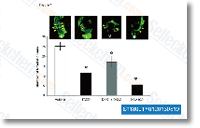The RepeatMasker analysis unveiled that eleven. 17% of contigs harbored a repeat as well as most represented ele ments belong to SINE families. The latter end result is in line together with the studies performed during the Indonesian coelacanth genome, through which the activity of SINE aspects in Latimeria was inferred. The identification of LF SINEs and DeuSINEs in L. menadoensis transcriptome might verify that these components are basically energetic. In addition, since their conservation in increased vertebrates, this move ment may predate the common ancestor of Crossopter ygians, for in excess of 400 Myr. On the other hand the occurrence of total SINEs in contigs bearing protein coding sequence might reveal the gain of new practical roles, as previously described in tetrapod genomes.
Regarding the activity of LINEs, the second most rep resented interspersed factors, the InterProScan analysis recognized amino acidic domains linked to these autono mous retrotransposons. Obatoclax manufacturer Chicken Repeat 1 factors are the most abundant amongst LINEs. In contrast to the G. gallus genome wherever these aspects are predominant but, with extremely few exceptions, nonfunctional, in Latimeria they appear to be active. Fragmented LTRs and ERVs had been recognized while in the tran scriptome. This consequence is in agreement with the analyses on Foamy like retroviral elements just lately found in L. chalumnae genome by Han and Worobey exhibiting numerous frame shifts and halt codons. The abundance in the Harbinger DNA transposons in L. menadoensis genome suggests that Class II factors represent a exceptional fraction with the coelacanth TEs, having said that our examination indi cates that couple of DNA components are expressed.
This discord ance might be associated towards the lack of coelacanth specific sequences belonging to this class during the RM database or to their propagation mode. The identification of mobile ele ments in transcriptomes sheds light on an unexpected genome dynamicity in an organism regarded to be a liv ing fossil even from a molecular selleck chemical viewpoint. RNA seq mapping around the African coelacanth genome Greater than half from the sequence data produced by the RNA seq of L. menadoensis liver and testis mapped to the genes annotated by Ensembl within the L. chalumnae genome, revealing an general great annotation on the African coelacanth transcripts, although in some cases the RNA seq data developed within this research could provide some proof of further exons and al ternative splicing, provided that the 6.
97% of your reads corresponded to regions annotated as introns. Nevertheless, a rather high proportion of reads, near to 40%, could not be mapped around the genes annotated by Ensembl, consistently with all the method adopted by Ensembl for that annotation pipeline, that is automated and largely centered on protein coding gene  versions. In fact, almost the 35% in the sequencing reads could map over the assembled genomic scaffolds outdoors from the an notated gene boundaries, revealing that a relevant por tion of the transcripts expressed from the Indonesian coelacanth liver and testis might correspond to genes which were not annotated through the Ensembl RNA seq annotation pipeline.
versions. In fact, almost the 35% in the sequencing reads could map over the assembled genomic scaffolds outdoors from the an notated gene boundaries, revealing that a relevant por tion of the transcripts expressed from the Indonesian coelacanth liver and testis might correspond to genes which were not annotated through the Ensembl RNA seq annotation pipeline.
ATPases Signal
Besides exchangers, other categories of transmembrane ATPase include co-transporters and pumps.
